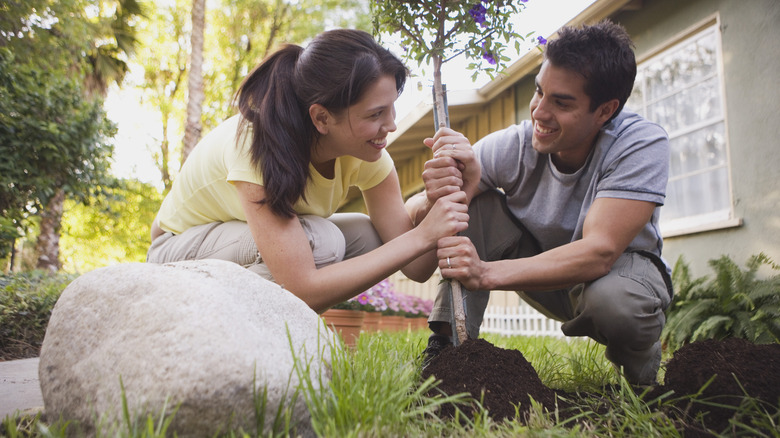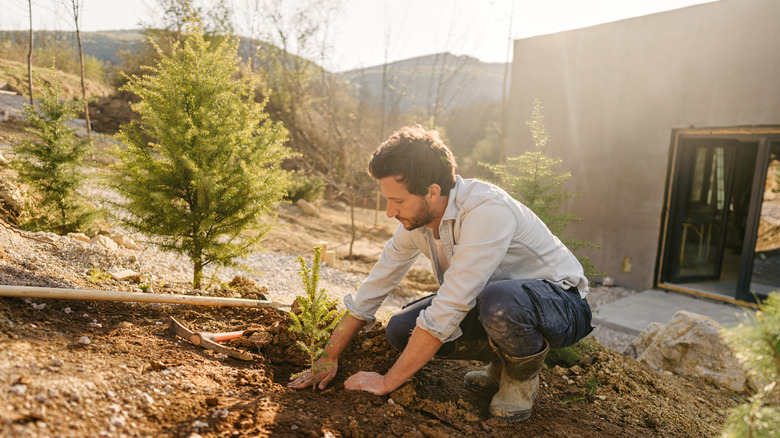The Simple Water Trick To Try Before Planting A Tree In Your Yard
Planting a tree in your yard is an exciting endeavor that brings numerous benefits both personally and environmentally. On a personal level, it's an investment in the future, as trees often outlive their human caretakers, providing beauty and a lasting legacy. The act of planting itself is fulfilling, symbolizing growth and a commitment to nature. Environmentally, trees play a crucial role in mitigating climate change. They absorb carbon dioxide, release oxygen, and contribute to overall air and water purification. Trees also provide habitat for wildlife, attracting a number of birds and other creatures to your yard, adding to the biodiversity around your home. If you're looking to plant a tree in your yard, one of the best steps you can take before plopping a trunk in the ground is to hydrate the roots to promote easy and healthy acclimation.
According to the Arbor Day Foundation, most young trees for individual planting typically arrive in containers or as bare-root specimens. Containerized trees come in pots with soil around their roots, offering convenience and a higher chance of successful transplanting, but do not require pre-soaking before planting. Bare-root trees, on the other hand, are shipped with their roots exposed, usually wrapped in damp material to retain moisture. If your tree arrives bare-root, start by removing all of the packaging material from around the tree roots. Once that step is complete, your bare-root tree is ready to take a rejuvenating plunge into a water bath before making a home in your yard.
How to soak your tree
Soaking a tree's root ball in a bucket before transplanting is a beneficial practice that helps prepare the tree for its new environment. Choose a bucket large enough to comfortably accommodate the root ball, typically a five-gallon bucket for smaller trees and a larger container for more mature ones. Fill the bucket with water that is at ambient temperature or slightly warmer. It's best to use non-chlorinated water, as chlorine can be detrimental to the tree's roots. Rainwater or well water without chemical treatments is an excellent alternative.
Before proceeding, trim away any dead, soggy, or dried out roots or fibers from the root ball. Once your tree is ready for soaking, gently lower it into the bucket, ensuring the roots are fully submerged. The Arbor Day Foundation recommends soaking the tree for at least 4 to 6 hours before planting, depending on the size and type of the tree. This duration allows for optimal rehydration of the root ball and helps reduce transplant shock.
If the tree is particularly large or heavy, consider securing it in an upright position during soaking to prevent tipping. Ensure the tree is stable within the bucket and that the water level is sufficient to cover the entire root ball. After the soaking period — no more than 24 hours — remove the tree from the bucket, allowing excess water to drain, and proceed with the transplanting process immediately so that the roots do not dry out before planting.
Benefits of soaking your tree before planting
Soaking your tree's roots before planting provides several advantages that contribute to the tree's successful establishment and long-term health. First, soaking the roots promotes hydration and reduces transplant shock. When a tree is removed from its nursery container or balled-and-burlapped, the roots may experience stress due to the disruption of their natural moisture balance. Soaking the roots in a bucket allows them to absorb water, ensuring that the tree is well-hydrated before facing the challenges of transplantation. Adequate hydration helps the tree acclimate to its new environment by minimizing stress on the roots, supporting the development of new root growth, and enhancing the overall vitality of the tree.
Secondly, soaking loosens compacted roots and soil without the need for teasing. In a container or during transport, a tree's roots may become compressed or entangled. Soaking the roots in a bucket helps to gently separate and untangle them, allowing for better root spread upon planting without disturbing them manually. This is crucial for the tree's ability to anchor itself in the soil, absorb water and nutrients efficiently, and establish a strong foundation for growth.
Finally, soaking provides an opportunity to inspect and trim damaged or circling roots. While the roots are immersed in water, it becomes easier to identify and address any issues such as root deformities or damage sustained during transportation. Trimming these problematic roots encourages the development of healthier, more robust roots that will better support the tree's long-term well-being.

